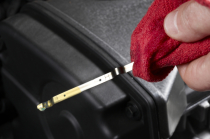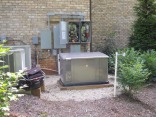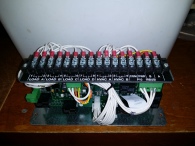
ncgenerators.com
Load management for residential or small business generator systems for Raleigh, Durham, Chapel Hill, Greensboro, and surrounding counties.
When you are using a generator, meaning this is the only source of electricity providing power to your home or business, all your electrical loads or work is being taken care of by the generator. This said, when you are using different appliances in your home, air conditioning, heat, well pumps, hot water heaters, refrigerators, lighting, power for the TV, washers, computers, the list goes on and on, different levels of load or work is being introduced to the generator. As you use your home, even if you understand electricity with respect to the electrical load for each appliance being used, it would be hard to calculate just how much work you are asking of the generator. The electrical load attaching to your generator changes as you use your home, some loads are automatic and you are not necessarily turning them on and off, they work off thermostats or automatic controls of certain appliances. Generators no matter what the size, have limitations and all structures, home or business, have different amounts of electrical loads or potential work which can attach to the generator.
Until recently, especially in the residential markets, implementation of adequately sized generator systems did not always occur; this introduced overload potentials, creating bad scenarios for both the generator system and the loads attaching to the generator system. This usually would result in high repair cost or replacement of damaged appliances and or generator systems.
The potential overload issues created the need for a new electrical rule or standard which required load calculations for generator systems being installed on any type structure. This means, there is a mathmatical formula, the electrical level or amount of work required by the generator for each appliance, receptacle or lighting fixture that can be used during a power outage condition is inserted into this formula. The result of the mathmatical calculation tells you what the potential level or amount of work you want the generator to do.
In 2008 this requirement for load calculations was implemented by the National Electrical Code Board and then adopted by all local inspection jurisdictions. Like with other things, there is exception, automatic load management with respect to the needed size generator, if that exception. Due to the cost associated with the installation of the larger generator systems needed to satisfy this new rule, manufacturers started utilizing load shedding or management practices so as to minimize the generator system size and ultimately cost.
The load shedding or management practices consisted of automatically disconnecting certain loads before a user could overload the generator. This would eliminate the overload potentials which may exist for generator systems. Today, it is most practical to manage the larger loads, air conditioning, electric heat, dryers, ovens, ranges, cooktops. Most lighting and receptacle loads are fairly insignificant as they only provide 3 watts per square foot of the structure with respect to the total load connection potential. It is possible to prioritize the way you want management done. Priority levels for certain loads are determined by how individuals use the electricity in their home or business.
An example of caculated load for a home, a 2500 square foot home with 2 heat pumps with auxiliary heating strips in the air handler, an electric hot water heater, dryer, free standing range, one kitchen with dishwasher, disposal, and space saver style microwave, one laundry, and a well pump, the calculated load would be approximately 37 KW depending on the size of the auxiliary heating strips. This means for generator success without potential damages created by overloads and then also to accomodate the requirements of electrical codes, you would need to use a 37 KW generator or a smaller size system with automatic load management. For the smaller size with management scenario, a 20 KW system fueled by natural gas which really is only 18 KW when fueld by natural gas and dependent on the manufacturer, the ratings may actually be inflated, but this is another story. For our example, we will assume everything with regards to rating is correct and we understand the stated 20 KW rating on the generator is only 18 KW with fueled by natural gas. For this example using the 18 KW systems, for the 37 KW load connection potential, you would have to manage 19 KW of the load.
The 20/18 KW whole house generators being sold thru the different venues, is not large enough for this structure unless several of the appliances are routed thru the load management portion of the generator system. So what do you shed? For an example let us say you shed the dryer and the free standing range, this will eliminate 4.5 KW of the overload potential, so what do you choose next? Most load managment systems are designed to shed air conditioning and heating loads or the larger 240 volt appliances like the free standing range, dryer, hot water heaters, etc. However these may be the appliances you really need during an extended outage so careful and experienced planning is necessary to reduce inconveniences which can occur with load management.
It is certain that load management has created fewer incorrectly sized systems for structures however load management does present the need for careful thought as to how to implement. Most load management programs allow for the shedding of several appliances, this in turn reduces the load which can connect to the generator which in turn means a smaller system. This said, consideration should be given to the inconveniences that load management can create. If the generator system selected for use is too small and several appliances are connected thru the load management portion of the system, they may never connect. For appliances which you really want, it would be extremely inconvenient if these loads disconnected every time you go to use them.
| Appliance | Wattage |
| Oven | 5700 - 8400 watts |
| Cooktop | 4200 - 5700 watts |
| Range | 5700 watts |
| Microwave | 750 - 1500 watts |
| Refrigerator | 400 - 800 watts |
| Dishwasher | 1125 watts |
| Disposal |
1050 watts |
| Kitchen Appliance Circuits | 3000 watts |
| Washing Machine | 1500 watts |
| Hot Water Heater |
4500 watts |
| Lighting & Receptacle Loads | 3 watts per square foot |
| AC | 2000 - 7000 watts |
| Gas Furnace | 400 - 800 watts |
| Heat Pump | 2000 - 7000 watts |
| Air Handler with Heating Strips | 5000 - 15000 watts |
| Dryer | 5700 watts |
| Hot Tub |
14500 watts |
Something to consider; heat pumps systems present unique challenges to generators. When the heat pump is called to work by the thermostat setting, both the heat pump load and the auxiliary heating strip load can attach to the generator simultaneously, until the heat exchanger of the air handler is warm enough due to the heat pump functions; at this time the strip heating load would shut down. Additionally heat strips associated with a heat pump system are also used if heat pumps go thru a defrost cycle.
For an average, mid size system, this would equate to appx. 60 amps. The output capacity of a 20 KW system, fueled by natural gas is 75 amps; just the one heat pump system would equal 80% of the generator's capacity. Most load management systems would shed the heat pump or the air handler as soon as they tried to connect; how the priorities were set, would determine which would shed first.
As noted careful planning is essential, We Can Help!


